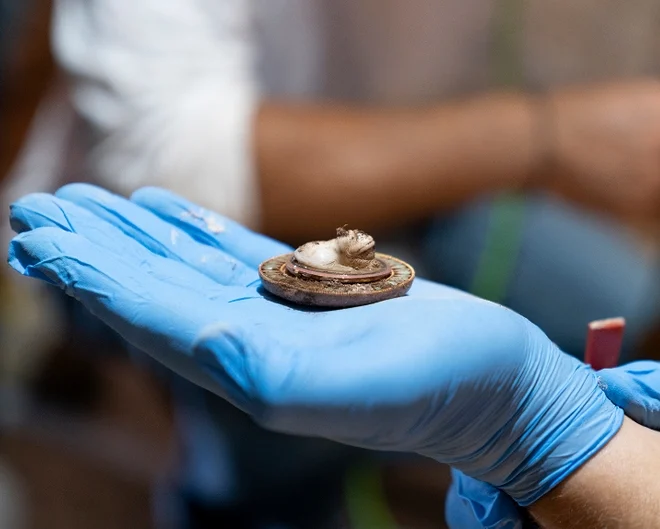Discovery of a Remarkable Burial Site
In 2018, Greek archaeologists made an extraordinary discovery on the island of Sikinos—a nearly untouched grave of a noblewoman adorned with exquisite gold jewelry. An inscription at the burial site identified her as Neko (Νεικώ in Greek), though her precise status and role in Sikinos society remain a mystery. Sikinos, a small island in the Cyclades, is situated between Ios and Folegandros.
A Hidden Mausoleum Preserving History
The remains of the noblewoman. Credit: Ministry of Culture
The noblewoman’s grave was found within the vault of the Episkopi monument, a unique Roman-era burial structure that was later transformed into a Byzantine church and monastery. Despite the passage of time and multiple uses of the building, her tomb remained undisturbed—hidden in a concealed section between two basement walls, protecting it from grave robbers.
Treasures of the Past: Gold Jewelry and Artifacts
Inside the grave, archaeologists unearthed a dazzling collection of gold jewelry, including wristbands, rings, a long golden necklace, and an intricately carved cameo buckle depicting a female figure. The burial also contained glass and metal vases, along with fragments of the deceased’s clothing, offering a glimpse into her opulent lifestyle.
A Noblewoman of Significance
The Greek Ministry of Culture highlighted that the abundance of jewelry suggested Neko was a person of considerable status. The well-preserved mausoleum was likely constructed specifically to honor her memory, reinforcing her prominence in society.
“We were incredibly fortunate,” stated Dimitris Athanassoulis, Director of the Ephorate of Antiquities of Cyclades. “This mausoleum belonged to Neko. It is rare to uncover such a significant monument with a known identity. We have her remains, her name, and the structure built in her honor.”
Unraveling Neko’s Story
Pieces of golden jewelry were found in her grave. Credit: Ministry of Culture
Although it is unclear whether Neko was a native of Sikinos or had connections elsewhere, researchers continue to investigate her origins and significance. “We are only at the beginning of our research,” Athanassoulis remarked.
Jewelry’s Lasting Legacy in Ancient Greece
Throughout history, archaeologists in Greece have uncovered numerous artifacts that reflect the culture and values of ancient societies. Jewelry, in particular, has long been a symbol of status and personal expression. Renowned Greek archaeologist Polina Sapouna Ellis recently shared her perspective with The New York Times, emphasizing the emotional connection ancient people had with their adornments.
“I’ve seen corpses still wearing their gold jewelry, underscoring its deep significance,” Ellis explained. “Gold endures—it is precious, durable, and what ultimately survives.”
The well-preserved mausoleum where the grave was found. Credit: Ministry of Culture
Neko’s grave is a powerful testament to this enduring legacy, shedding light on the lives and customs of the past while preserving a moment of history in exquisite gold.










